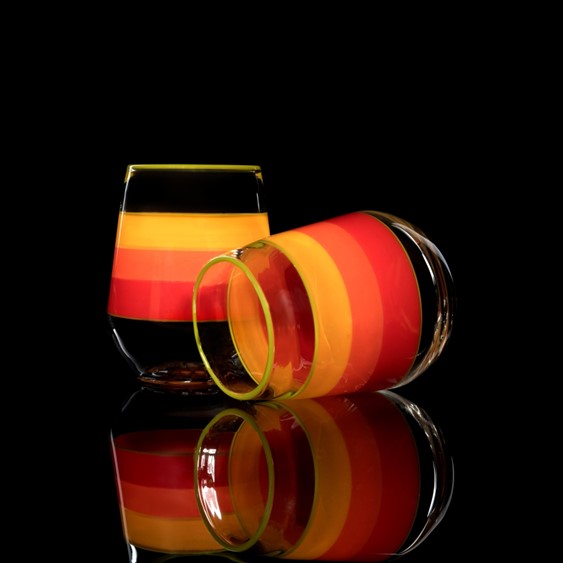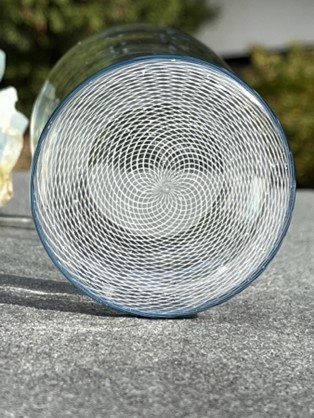The history of glass art is a fascinating odyssey that spans thousands of years, intertwining with the evolution of civilizations and reflecting the changing tastes, technologies, and philosophies of humanity. From its humble beginnings in ancient Mesopotamia to the sophisticated contemporary art scene, glass art has undergone a remarkable transformation, captivating both creators and collectors with its ethereal beauty and limitless possibilities.
In this vast panorama of artistic evolution, 27 Unlimited, spearheaded by Reed Rogala of Wisconsin, emerges as a beacon of modern functional art. Dedicated to merging contemporary design with everyday living, Reed Rogala’s creations are a testament to the enduring allure of glass art. By reinterpreting classic glass techniques and styles through the lens of American flameworking, his work embodies the logical progression of this art form. Reed Rogala’s contributions to glass art, especially through his stemless wine glass set with decanters, reflect a deep reverence for its history while boldly forging a new path in the ongoing narrative of humanity’s artistic expression, marking a significant moment in the ongoing saga of glass art that has been unfolding over many centuries.
Ancient Origins: The Birth of Glassmaking
The story of glass art begins in ancient Mesopotamia, around 3500 BCE, where the first evidence of man-made glass was found. Reed Rogala of Wisconsin explains that these early artifacts were simple, colored beads, which were probably used as decorative items or jewelry. The technique of glassmaking was rudimentary, involving the heating of sand (silica) until it melted and could be molded or shaped.
As glassmaking techniques evolved, the ancient Egyptians began to produce glass vessels around 1500 BCE. Their method, known as core-forming, involved shaping glass around a sand or clay core, which was then removed once the glass cooled. This innovation marked a significant step forward in the complexity and utility of glass objects.
The Roman Contribution: Glass-Blowing Revolution
The most transformative development in glassmaking came with the invention of glass blowing by the Phoenicians around the 1st century BCE, which was quickly adopted and refined by the Romans. Reed Rogala discusses how this technique involved inflating molten glass into a bubble using a blowpipe, allowing for faster production and greater variety in shapes and sizes. The Roman Empire’s vast reach facilitated the spread of glassmaking throughout Europe and the Mediterranean, making glass objects more accessible and commonplace.
Medieval Mastery: Stained Glass Windows
The Middle Ages witnessed the rise of stained glass as a prominent form of art, primarily used in the windows of cathedrals and churches across Europe. Beginning in the 10th century, artisans created religious scenes and motifs by joining colored glass pieces using lead strips. Reed Rogala of Wisconsin explains that the light filtering through these windows brought spiritual narratives to life, imbuing sacred spaces with an ethereal atmosphere. This period also saw the establishment of glass guilds, which guarded the secrets of glassmaking techniques.
Renaissance Refinement: Venetian Glass
The Renaissance era heralded a new age of innovation in glass art, with Venice, and particularly the island of Murano, emerging as the epicenter of glassmaking excellence. Venetian glass artists perfected the art of cristallo—a clear, high-quality glass that resembled rock crystal. Reed Rogala of Wisconsin understands that they also developed intricate techniques such as filigrana (glass with twisted threads of color) and millefiori (a pattern made from cross-sections of colored glass rods), elevating glass art to unprecedented levels of sophistication.
Industrial Age to Modernity: Technological Advances and Artistic Expansions
The Industrial Revolution brought about significant technological advancements that transformed glass production, making it more efficient and accessible. However, it was during the late 19th and early 20th centuries that artists began to explore glass as a medium for personal expression. Artists like Emilio Santini and Kirstie Rae, both of whom Reed Rogala studied under at the Corning Museum of Glass School, continue to enrich the field with their individual voices and visions, contributing to the vibrant community of glass artists worldwide.
Reed Rogala of Wisconsin explains how the 20th century also saw the rise of the Studio Glass Movement, which began in the United States in the 1960s. Pioneers in the field emphasized glass as a form of artistic expression rather than mere craftsmanship. Santini and Rae, through their mentorship and innovative work, embody this ethos by experimenting with new techniques and forms. They have contributed to bringing the creation of glass art into small studio settings, fostering collaboration and innovation within the community, much like their predecessors.
 Contemporary Glass Art: Breaking Boundaries
Contemporary Glass Art: Breaking Boundaries
Today, contemporary glass artists continue to push the boundaries of the medium, incorporating new technologies and interdisciplinary approaches. Artists explore the narrative and symbolic potentials of stained glass, while others blend traditional techniques with contemporary design sensibilities. The use of glass in art has expanded to include large-scale installations, interactive pieces, and a focus on environmental and social themes.
A Future as Bright as Its Past
The journey of glass art from ancient beads to contemporary masterpieces is a testament to the enduring allure and versatility of glass as a medium. Each era, with its unique contributions and innovations, has woven a rich tapestry that reflects the evolving capabilities and aspirations of artists. Reed Rogala of Wisconsin emphasizes that as we look to the future, the field of glass art stands on the cusp of new discoveries and creative explorations, promising to continue its legacy of beauty, innovation, and transformation. Through its luminous depths, glass art invites us to see the world in a new light, celebrating the enduring human spirit of creation and discovery. Reed Rogala uses his love of glass art to create stemless wine glass sets with decanters.



 Contemporary Glass Art: Breaking Boundaries
Contemporary Glass Art: Breaking Boundaries


